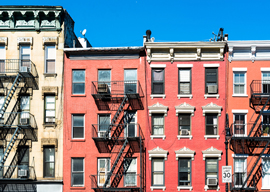
November 01, 2014

Source: Shutterstock
Autumn in New York, they even wrote a song about it that was a great hit sixty years ago. Last weekend the sky was awash in blue, Manhattan at its best, with Central Park gleaming in green and only the crowds marring the views. New York has changed dramatically these last fifty years, but what city has not? The place has gotten richer, but not better as far as the quality of life is concerned. That ghastly Bloomberg midget sold the place to the highest bidders, so developers are singing his praises, not unlike bootleggers paying homage to Al Capone. Manhattan was always chic in the upper east and west sides, but bohemian and gritty and artistic downtown. No longer. The place has been airbrushed for good, a playground for Indian and Chinese billionaires, Russian molls, Arab crooks, as well as American and European money managers, corporate lawyers and international jetsetters. In other words, the place stinks with new and unacceptable money and manners. Developers are king, long live funny money.
The luxurious downtown loft spaces that used to be cheap artist studios in the Fifties and Sixties, were once failed factories and warehouses during the Forties. Economic and cultural evolution is a constant in many cities, but more so in the city that never sleeps. (In fact, it is impossible to sleep when drilling begins at 7.a.m. and one is a night owl.) Cranes are everywhere, new high rise condos sprout like weeds, a horror to end all horrors stands over Madison Avenue in midtown, like an undulating middle finger to good taste, built by a horrible man called Macklowe that I had the bad luck to go to prep school with. Empty apartments sit by the thousands, owned by zillionaires hedging their bets in case the regimes that enabled them to make their money get their comeuppance. This is no longer the city that Fitzgerald’s exuberant prose romanticized, or Gershwin’s syncopations made us jostle and throb. No siree!
Still, memories of a beautiful woman die hard, and that also goes for cities or towns. Take for example Edward Hopper’s ghostly diner that became an emblem of the city, “Nighthawks.” The painting alludes to the city’s alienation and loneliness, Hopper’s most recognizable work. The location of the diner has never been established, although folklore has it that it was on Greenwich Avenue and 11th Street. Records, however, show that only a gas station was there from the 1930’s through the 1970’s. So where was the most famous diner in the world situated? The mystery was solved some years ago by one Jeremiah Moss, a Manhattan enthusiast, who envisioned the island as a Hopper painting filled with golden, melancholy light. (A bit like the poor little Greek boy.) He discovered an interview in which Hopper himself admitted that there was no such diner, just an all-night coffee shop on Greenwich Avenue that he enlarged and simplified and thus painted the loneliness of a large city. Great stuff.
Well, all that loneliness has gone the way of high button shoes, with bakeries and curved windows and dark bricks that loom in the background all disappearing, all tumbling down to make room for glass office towers and ritzy condos. Thank God the great Hopper is not here to see the destruction. They say that the longer one has lived in Manhattan, the more one loves the vanished city, and no one loved the city more than Hopper or yours truly. And, of course, the great E.B. White, who wrote about the great gift New York bestows, “that of loneliness.”
Luncheonettes, newsstand advertisements for 5-cent cigars, automats, and bakeries aside, what I miss more than all of them put together are the places I used to escape to when school and a foreign language called English got too much: The movie palaces that resembled ocean liners from the outside, with immense pillars triumphantly reaching skywards, and smooth curves like a giant woman’s hips. They have all been torn down and replaced by shopping blocks and superstores selling those machines people look at 24/7. Today’s dreary multiplexes have replaced these wonderful over the top palaces, as today’s ghastly films have replaced those dreams one got excited about as the spectacular interiors went dark.
Oh yes, I almost forgot. What about those dark red brick four story houses that lined the avenues with their wrought iron fire escapes standing guard? So called sophisticates called the fire escapes architectural eyesores, but when was the last time any so called sophisticate got it right? Criminals ruined London in the Sixties and New York in the 2000’s, with their glass boxes and inhuman sizes. Fire escapes were beautiful to look at when I was a child, and I still identify them exclusively with the city’s streetscape. Carnegie Hall has them stretched around the back, and someone once called fire escapes “the urban equivalent of the American front porch.” Hear, hear! Norman Rockwell didn’t do too many of them, he was small town rural, but Hopper did and that’s good enough for me. Lenny Bernstein had Maria singing on a fire escape in West Side Story, and Grace Kelly climbed up one to spy on Raymond Burr in Hitchcock’s Rear Window. Poor people slept on them during the hot nights of August, and Holly Golighty sang Moon River on one. What wouldn’t I give for the glass boxes to disappear and for more fire escaped four story houses to come back? Anything and everything, I’d even forsake a threesome with Keira Knightly and Jessica Raine.